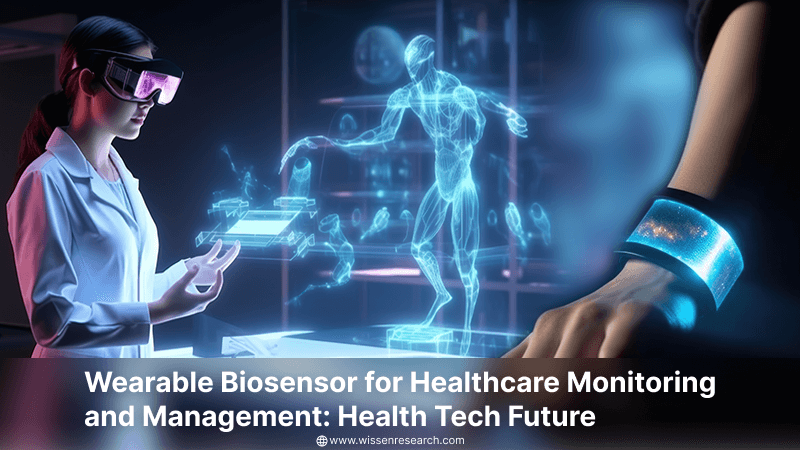Subscribe our newsletter
Please Subscribe our news letter and get update.

“Wearable technology will continue to transform the way we monitor and manage our health, providing real-time data and insights that can inform our decisions and improve our outcomes.” – Dr. David Albert
WBS devices have become increasingly popular in the medical, pharmaceutical, and food processing industries. These devices provide real-time data on various body parameters, enabling individuals to take proactive measures to improve their health. Biosensors are worn on, in, or near the human body to monitor and diagnose patients, measure vital signs, and detect early indicators of disease. With the growing aged population worldwide, wearable health monitoring devices are gaining attention in the medical and research fields.
If you are a tech enthusiast, this post will provide all the information you need. It will cover wearable biosensors, key enhancements, advantages, market trends, management and leading patents related to this technology.
So, read on!
WBS are small, compact electronic devices that can be attached to wearables (such as watches and wristbands), wearables (T-shirts, socks, shoes), and wearable accessories (glasses and helmets). They facilitate two-way communication between patients and physicians.
In communication, a processor or microprocessor processes the target signals that come from the biosensors. Then, a transducer converts the target signal into a computable parameter, and the user interface allows us to see the result. In addition, wireless technology and communication technologies have advanced, offering wearable devices, such as watches and bands, that can be used to simultaneously process and analyze biomarkers for healthcare, which has been improved.
The amalgamation of sensor miniaturization, integration, and advanced data analysis empowers wearable biosensors to enhance accuracy and reliability. Real-time monitoring of vital physiological signals such as heart rate, blood pressure, glucose levels, and oxygen saturation becomes easy with these biosensors. Any abnormality or irregularities in the vital physiological signals will be recorded and can be shared in real-time.
Wearable gadgets play a key role in monitoring vital health parameters and managing the body’s health condition. Integrating advanced biosensors empowers these gadgets to provide accurate data, better analyze vital health parameters, and assist in making informed decisions. The key advantages of biosensors include the following;
The future of biosensors in health monitoring and control is promising, with many opportunities for innovation and further development. Some key areas of focus and potential development include:
According to recent research, the global WBS market was valued at USD 5000 million by 2022 and is expected to grow at a constant annual rate of 10.00%, reaching USD 9000 million by 2028.
The increasing adoption of biosensors in healthcare has led to an increase in patent applications focused on this technology. Companies are trying to innovate technology to stay ahead of the competition. The field is governed primarily through patents in communications, energy efficiency, signal processing, and sensor design. This framework emphasizes the importance of intellectual property in the delivery of innovation and technological development.
In the biosensors market, major players such as Apple, Samsung, Fitbit (now owned by Google), Garmin, Huawei, and others offer feature-packed smartwatches and fitness trackers with advanced health monitoring capabilities.
The invention discloses a ring consists of a microprocessor, an EDA sensor, and a pulse oximeter interfaced with a microprocessor in the body. A wearable biosensor ring may consist of three main components: 1) A hardware system, including sensors, a collects physiological data and communicates with them through hardware 2) wireless network protocols for communication between hardware and software; and 3) a software system including a processing unit for extracting and analyzing data to a meaningful level.
The invention features a health monitoring device and a wearable device. This invention used a light source and a light sensor to monitor physiological parameters to measure the user’s heart rate. Furthermore, it is also used to measure other physiological parameters beyond heart rate, such as blood oxygen levels.
The invention discloses a biosensor includes at least one photoplethysmograph (PPG). PPG can be used to measure heart rate (HR) and heart rate variability (HRV). The biosensor also has a temperature sensor. One or more devices worn by the human and perceive information from the biosensor in any manner including auditory and tactile and, in some embodiments, specified information or patterns in such cases may trigger warnings.
Conclusion:
It is expected to grow rapidly shortly. Advances in sensor technology, artificial intelligence, and data analytics will increase their performance and ease of use. Combining emerging technologies such as augmented reality and blockchain can open up new healthcare services and disease prevention possibilities.
Interestingly, it hold great promise to revolutionize health care and management. With technological advances and growing interest from large corporations, these devices are on their way to reshaping healthcare delivery and empowering individuals to manage their health like never before. With continued innovation and investment in this area, it is anticipated to have a major impact on shaping the future of healthcare. The future looks incredibly bright for improving health outcomes and quality of life.
Wissen Research is a reputable IP consulting firm with over ten years of experience in assisting leading global corporations, Fortune 500 companies, small businesses, and onshore IP law firms in navigating the complexities of the intellectual property domain while staying within budget.
Services:
Connect with our experts and discuss your project-related queries today!
Authored by – Manish Gupta